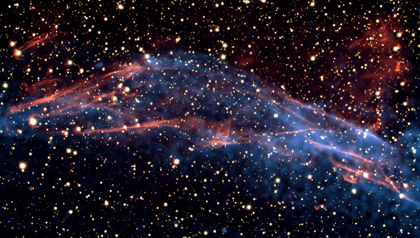A Super-Efficient Particle Accelerator
This image of data from NASA's Chandra X-ray Observatory and the European Southern Observatory's Very Large Telescope shows a part of the roughly circular supernova remnant known as RCW 86. This remnant is the remains of an exploded star, which may have been observed on Earth in 185 AD by Chinese astronomers. By studying this remnant, a team of astronomers was able to understand new details about the role of supernova remnants as the Milky Way's super-efficient particle accelerators. The team shows that the shock wave visible in this area is very efficient at accelerating particles and the energy used in this process matches the number of cosmic rays observed on Earth.
The VLT data (colored red in the composite) was used to measure the temperature of the gas right behind the shock wave created by the stellar explosion. Using X-ray images from Chandra (blue), taken three years apart, the researchers were also able to determine the speed of the shock wave to be between one and three percent of the speed of light. The temperature found by these latest results is much lower than expected, given the measured shock wave's velocity. The researchers conclude that the missing energy goes into accelerating the cosmic rays.
|
||||||||||||||||||||||||||||




Visitor Comments (10)
Good evening,
As far as I can see the space is more beautiful than our planet. Maybe one day the Earth will become as beautiful and peaceful as the space.
Goodbye and thank you for all you are doing for mankind.
Posted by simonetta maria angelica on Friday, 07.10.09 @ 15:11pm
I recently read about a supernova explosion from the death of a massive star and I'm extremely curious to how long it takes for these planets to form? Also, I read that the carbon emitted from these are the reason we have bones that among other things. This heavy element enriched gas will be incorporated into future generations of stars and planets. Without supernova the fiery death of massive stars there would be no carbon oxygen or other elements that make life possible (http://map.gsfc.nasa.gov/universe/rel_stars.html big bang theory).
Posted by Allyson on Wednesday, 07.8.09 @ 14:52pm
Very cool results, excellent science. I'm curious about how it was determined that the supernova affected cosmic rays observed here on earth? If the shockwave travels between 1 and 3 percent of the speed of light and the explosion was first observed about 2250 years ago, it should have affected the cosmic rays here from about 1940 to 1980. Were cosmic ray observations being recorded with enough accuracy back then to form a reasonable correlation? Or is my math off.
Thanks
Posted by David Guidos on Tuesday, 07.7.09 @ 11:01am
Oh my god, I was interested in astronomy and space researches in magazines and books which I could get here in Egypt what a difficulty. Now I am online with the very up-to-date well explained matter immediately from your and other telescopes sites. Thank you my friends and waiting for more revolutionary theories and views.
Posted by Salah abo elenin on Sunday, 07.5.09 @ 17:21pm
I take advance of this opportunity to give you my congratulations and tell you that my spirituality feel a firm ground when I realize about the creator of all this marvelous. God is unique, never the man could be able to understand all.
Posted by Edgar Samuel Ortiz Ch on Sunday, 07.5.09 @ 09:04am
That’s fabulous really scintillating.
Unfortunate part is that these type of seller facts remind us that how insignificant still we are when we talk about the exploration of this universe.
Posted by Sarwar Tipu on Friday, 07.3.09 @ 23:46pm
You provide an excellent service sharing information with the general public. We appreciate your efforts. Keep up the good work.
Posted by Doris Smart on Thursday, 07.2.09 @ 19:13pm
Thanks a lot Chandra, for helping us understanding more the cosmological phenomena and the mysteries of astrophysics. Best regards to all of you.
Posted by Angela on Thursday, 07.2.09 @ 11:36am
I am always interested in cosmological phenomena. Chandra is doing a fantastic job.
Thanks and congratulations. I am looking forward to new discoveries.
Posted by A M Qureshi on Thursday, 07.2.09 @ 09:18am
As a layman, I am a retired mechanical Engineer, your site helps in understanding the mysteries of astrophysics. To me without having to dwell deep into the theories I get an understanding of the stellar events. Thank you. May you keep progressing and my best wishes to your team.
Posted by AK Sharma on Wednesday, 07.1.09 @ 23:28pm